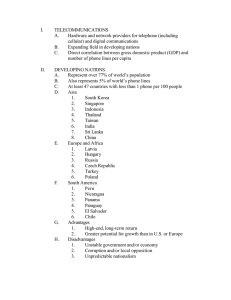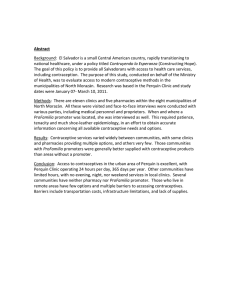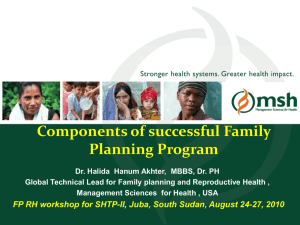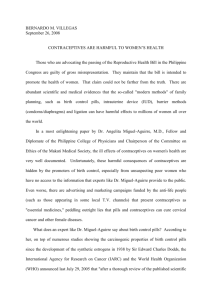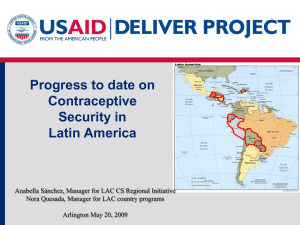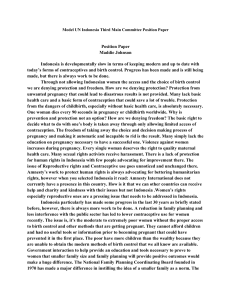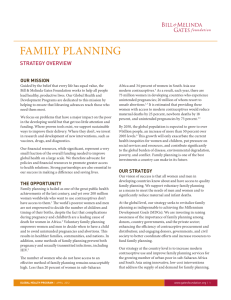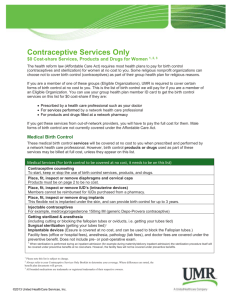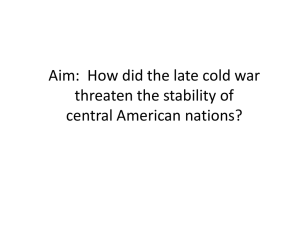USAID | DELIVER PROJECT PowerPoint Presentation template (01
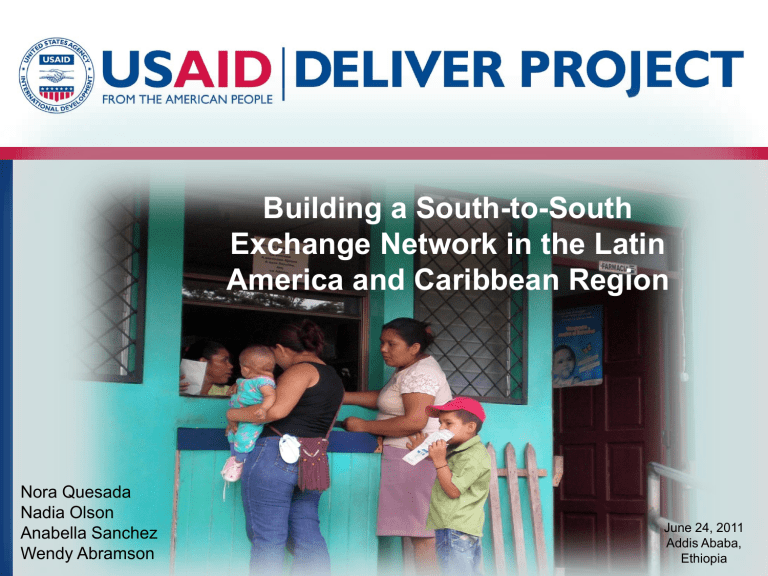
Nora Quesada
Nadia Olson
Anabella Sanchez
Wendy Abramson
Building a South-to-South
Exchange Network in the Latin
America and Caribbean Region
June 24, 2011
Addis Ababa,
Ethiopia
In the summer of 2003, the USAID LAC BUREAU launched a Regional Initiative…
In Eight Countries:
Guatemala, El Salvador
Dominican Republic,
Bolivia…
…Honduras, Nicaragua,
Paraguay, and Peru
The inaugural event,
Contraceptive Security
Advocacy Conference ,
Managua, Nicaragua, July
2003
Completed country/ regional assessments
Formed most of LAC
CS committees
The Road Has Been Long and Winding…
We Learned Four Essential Principles
Along the Way…
Ensure Harmonization
Leverage Resources
Use Data for Decisions
Focus on Sustainability
We Have Come a Long Way…
2003
Phase-out process begins
Countries depend on contraceptive donations
Family planning mainly supported by donors
2006
Country assessments show CS challenges remain
CS committees active in eight countries
Various countries financing & procuring contraceptives
2011
Six countries financing 100% of contraceptives
Six countries procuring quality contraceptives at internationally competitive prices
Five countries managing integrated supply systems
We Built Roads Between Countries…
3 countries passed laws to protect financing and access to family planning
3 countries are better coordinating service provision
6 countries finance their contraceptives 100 percent
6 countries realize significant cost savings by procuring through UNFPA and other innovative options
5 countries are building integrated supply chains, based on the contraceptive model
2 countries manage their supply chains on their own, and one with minimal external assistance.
Contributed to Great Achievements…
100%
Contraceptive Financing from Country Governments
2006 –2010
100% 100% 100% 100% 100% 100% 100% 100% 100%
90%
85%
80%
70%
60%
50%
40%
81%
64%
54%
62%
53%
84%
75%
50%
45%
66%
80%
75%
53%
70%
37%
68%
44%
2006
2007
2008
2009
2010
30%
23%
20%
10%
10%
0% 0% 1% 0%
0%
Dominican
Republic
El Salvador Guatemala Honduras Nicaragua Paraguay Peru
Source: Olson, Nadia, Anabella Sánchez, Ángel Reynoso, y Nora Quesada. 2010. La Adquisición de Anticonceptivos en América Latina y el
Caribe: Un Análisis de Opciones Actuales y Futuras en Ocho Países. Arlington, Va.: USAID | PROYECTO DELIVER, Orden de Trabajo 1.
Notes: Donors provide the remaining funds to cover total public sector need in each country.
That Were Led by Local Leaders…
“The initiative helped me to develop a vision for closer collaboration between Ministries of
Health and Social
Security Institutions. We are working towards achieving the same objective but through different channels.”
Dra. Yesenia Díaz, Deputy Director of Health Services for the Insurance
Department, SSI, Dominican Republic
“The regional initiative provided crucial assistance.
We had the opportunity to share experiences with other countries and this helped us to broaden our approach to the topic and allowed us to move forward. Having this support strengthens us..”
- Dr. Esmeralda Ramirez,
Director RH Department, MOH, El Salvador
Who Helped Fuel Improved Outcomes…
Modern Contraceptive Use in LAC Countries
(Women in Union)
40
30
20
10
0
80
70
60
50
25
35 35
64
66
70
53
62
66
31
35
44
38
51
56
57
66
70
41
61
71
50
47
50
'98 '03 '08
Bolivia
'99 '02 '07
Dominican
Republic
'98 '02 '08
El Salvador
'99 '02 '09
Guatemala"
'96 '01 '06
Honduras
'98 '01 '07
Nicaragua
'96 '04 '08
Paraguay
'00 '04 '09
Peru
But We Still Have a Long Way to Go…
• Health sector reform is still a major challenge
• Developing lasting procurement options will be difficult
• The fight for financing to distribute contraceptives and other essential medicines never ends
• Huge disparities in access still exist in every country, especially among our adolescents, our indigenous, and our rural populations
• These supply systems still need to be fully embedded in the health system and used as a strategic pillar for delivering health services
Thank
nora_quesada@jsi.com
